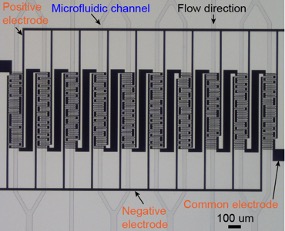This microfluidic sensor platform combines impedance spectroscopy—the process of measuring the dielectric properties of particles by frequency—with Microfluidic CODES sensor technology, Georgia Tech’s code-multiplexed sensor network technology for distributed electrical sensing. This combination allows for simultaneous measurement of both the spatial and the dielectric properties of particles via computational analysis of an electrical waveform. Additionally, the multi-frequency operation of the Microfluidic CODES’s multiplexed sensors simplifies the decoding of interfering sensor signals through independent component analysis (ICA). It also supports the computational decoding of the waveform produced by the device. This Georgia Tech system offers more robust particle assessment in lab-on-a-chip devices that could advance an array of biotechnology and health care applications.
For more information about Microfluidic CODES, see #7107/8032.
- Comprehensive: Simultaneously measures both spatial and dielectric properties of particles
- Streamlined: Helps resolve signal interference from coincident cells—a challenge of other assessment techniques
- Precise: Offers complex impedance as a new level of particle feature assessment, integrating it with other measurements such as elasticity and size for more predictive analyses
- Environmental monitoring
- Biotechnology
- Health care
Microfluidic impedance spectroscopy is a reliable technique for the label-free characterization of biological particles. It relies on the differences between complex impedances to discriminate different particles and typically employs a multi-frequency excitation to measure the particle frequency response. Since the output of the Microfluidic CODES system requires computational analysis, impedance spectroscopy offers a robust solution that allows for further characterization of the particles after the data is collected.
To see more technologies by Dr. Sarioglu and his team, please click here.

A diagram of the microfluidic device with 10 code-multiplexed Coulter sensors, each with a unique sensor signal

A coded sensor signal measured at four different excitation frequencies
